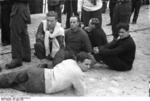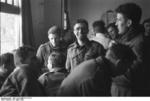Raid on Saint-Nazaire
Contributor: C. Peter Chen
ww2dbaseSaint-Nazaire was a port city in the department of Loire-Inférieure in France. Hosting the largest drydock facilities on the French Atlantic coast (350 meters long and 50 meters wide) and a brand new submarine base with 14 large pens, it was a natural target for the British. The Germans understood this well and strongly fortified the defenses there. Both sides of the estuary approach were fortified by men of Edo Dieckmann's 280 Naval Artillery Battalion and C. C. Mecke's 22 Naval Flak Battalion. Weapons used by the defense included four 150-mm howitzers, four 170-mm guns, and four 75-mm guns at Chémoulin to the southwest, and four 88-mm guns and ten 20-mm or 40-mm guns at Villès Martin nearby. Further away at La Baule were four 105-mm guns and two 240-mm railway guns. Across the estuary from Saint-Nazaire were four 75-mm guns at Saint-Gildas, another four at Le Pointeau and about ten 20-mm guns at Mindin. In the harbor area were around 30 single 20-mm guns, two quad 20-mm guns, around 15 40-mm guns, and the flakship Sperrbrecher 137 just off the new port. Heavy anti-aircraft defenses were also installed in the town. Radar stations were operating at Le Croisic and at Saint-Marc, and all the German positions had searchlights. About 1,000 troops manned these defenses, and there were a further 5,000 or so military personnel in the town. Excluding submarines, the German naval power was relatively weak, which included ten minesweepers, four small harbor defense vessels (Hafenschutzboote), and four torpedo boats.
ww2dbaseThe British plan for success was surprise. An air raid was to be launched to draw the attention of German defenses, providing the opportunity for British surface vessels to enter the harbor through the estuary. The British naval task force was to be centered around a destroyer and escorted by eight motor launches. The destroyer was to ram the docks to provide the commandos onboard a way to enter the dock facilities. The commandos would then attack the 24 targets, set off the explosives in the destroyer ramming ship, and make their escape. Additional commandos were to be delivered by the motor boats.
ww2dbaseLaunch of Operation Chariot
ww2dbaseOn 26 Mar 1942, Operation Chariot was launched under the command of R. E. D. Ryder for the naval forces and Lieutenant Colonel A. C. Newman for the commandos; the total number of personnel involved was 611. Destroyers Atherstone and Tynedale escorted the task force most of the way before the task force reached waters outside of Saint-Nazaire. Escorting the destroyer ramming ship Campbeltown (disguised as a German Möwe-class destroyer) was an enlarged escort fleet of 16 motor launches (although one of them returned for home before reaching Saint-Nazaire due to mechanical failure), one motor gun boat, and one motor torpedo boat. Campbeltown was commanded by Lieutenant Commander Stephen Halden Beattie, and her crew was reduced to the minimum size of 75. Onboard Campbeltown were 24 Mark VII depth charges, totaling 3.17 metric tons of explosives, rigged for the post-operation self-destruction. The motor gun boat MGB 314 was equipped with radar so that she could effectively act as the headquarters ship for the naval command. Motor torpedo boat MTB 74 carried special modifications that allowed her to fire delayed-action torpedo over torpedo nets. All motor boats were painted a special "Plymouth Pink" (actually a shade of purple) for night time camouflage.
ww2dbaseThe Approach
ww2dbaseThe diversionary bombing conducted by Whitley and Wellington bombers did little to draw German attention; if they had any effect, in fact, the bombing probably heightened the alertness of the Germans. Nevertheless, the naval task force was able to get within a few kilometers of the harbor before being detected at 0115. The searchlight teams did not find the British vessels until 0122, when the ships were only 2.8 kilometers from the harbor. Flying the German Kriegsmarine ensign and using a German Morse call sign, the British were able to cause much confusion among the German ranks for almost five minutes. At 0127, the Germans finally opened fire, prompting the British to lower the German ensigns and raise the Royal Navy ensign instead. At 0134, Campbeltown successfully rammed into the southern caisson, disembarking the commandos she carried as well as her entire crew.
ww2dbaseShortly after, Motor torpedo boat MTB 74 fired her delayed-action torpedoes at the lock at the old entrance, picked up about half of Campbeltown's crew, and started for the harbor exit. Her torpedoes were now lodged in the lock, and were set to detonate a few hours later.
ww2dbaseThe 17 smaller vessels had a difficult time on their approach. Eight of the launches were destroyed during the approach, with some destroyed boats suffering very high casualty rates. Several boats overshot the harbor entrance, and had to turn back through heavy fire to deliver their commandos. In the end, only a few of the commando teams delivered by launches made it ashore.
ww2dbaseThe Commando Raid
ww2dbaseThe commandos delivered by Campbeltown quickly and efficiently infiltrated the entire dock facility region, taking advantage of the German defenders still in relative confusion. The commandos were divided into two types of duties, demolition and protection. Those in charge of demolition carried explosive and otherwise lightly armed. While the demolition team found their targets, the protection teams guarded them with Thompson sub-machine guns and Bren light machine guns. The demolition teams were able to find and destroy all their assigned targets.
ww2dbaseThe difficult approach of the motor boats prevented them from making it to the shore; most of them simply engaged in rescue operations for those in the water. As a result, the British commandos were now left behind. Refusing to surrender, they attempted to regroup near the warehouses while under fire from the German 20-mm and 40-mm guns. At 0300, they attempted to cross a bridge into the main town, where they plan to break out into the open country. Just as the Germans reinforced the defenses with soldiers from the 679 MI Brigade, the British commandos made a charge across the bridge into the town, but soon realizing the Germans had already positioned roadblocks to prevent their escape into the country. Surrounded, the British continued fighting through dawn. The 200 survivors finally surrendered at 1000. Only five escaped out of Saint-Nazaire.
ww2dbaseEpilogue
ww2dbaseThe boats that made it back out to sea were aiming for a rendezvous point 46-km off Saint-Nazaire, where Atherstone and Tynedale were waiting. En route, two boats were destroyed by heavy German guns, including MTB 74; the loss of the two boats accounted for over half of the naval casualties of this operation. Another motor launch was lost at about 0630 when the German destroyer Jaguar commanded by F. K. Paul captured it after an hour of fighting with small arms. The British commanding officer of the motor launch did not surrender the vessel until 20 out of 28 aboard were wounded or killed. British commando Sergeant T. F. Durrant manned the Lewis gun during the entire battle despite being shot over 16 times; he eventually died of his wounds, and was given a Victoria Cross medal upon the recommendation of the German officer Paul.
ww2dbaseWhen the British task force reached the rendezvous point, there were only four boats remaining. Two were abandoned at that point due to damage, and the other two were abandoned later during an air attack.
ww2dbaseAt 1035, the charges aboard Campbeltown detonated (about 1.5 hours late). The explosion destroyed the caisson and killed 250 German soldiers and civilians in the immediate area. Recall MTB 74 launched several delayed-action torpedoes that were lodged in the old lock. They were fused to explode a few hours after launch, but they did not explode for another two days. When they finally detonated on 30 Mar, they killed 16 French civilians.
ww2dbaseThe raid on Saint-Nazaire cost the British 169 lives, while the Germans suffered 292 killed and 127 wounded. All but 27 of the British commandos were killed or captured, and only 27 escaped (22 of them via the motor boats because they were never delivered, and 5 of them escaped via Gibraltar after traveling through France and Spain). Although the casualty rate for the British was very high, the raid was considered to be a great success because all primary targets were successfully destroyed; in fact, the docks were damaged to such an extent that some remained unusable until 1947. This raid was later said to be the "Greatest Raid of All".
ww2dbaseSource: Wikipedia.
Last Major Update: Sep 2007
Raid on Saint-Nazaire Mapa Interativo
Photographs
 |  |  |  |
Raid on Saint-Nazaire Timeline
| 13 mar 1942 | Lieutenant Commander Stephen Beattie, commanding officer of destroyer HMS Campbeltown, was captured by the Germans at Saint-Nazaire, Pays de la Loire, France. |
Você gostou deste artigo ou achou este artigo útil? Se sim, considere nos apoiar no Patreon. Qualquer valor já vai ajudar! Obrigado. Por favor, ajude-nos a divulgar o site: Fique atualizado com WW2DB: |
Visitor Submitted Comments
10 Nov 2021 07:44:14 AM
My Grandad served with the Royal Navy and said to me he was one of the gunners of the MGB fitted with two oerlikon forward and aft involved with this raid. He said his boat esacped the raid and got beached on a spit and had to abandon ship. Crew managed to get ashore and were taken prisoner by the Germans, I would love to know more details about this but cant find his name on any sites??
21 Oct 2023 09:38:50 PM
When I was at Nautical college a Commander Southcott was I/C and told us he was on the St. Nazaire raid on an MTB. I have been unable to confirm this. Can you help?
All visitor submitted comments are opinions of those making the submissions and do not reflect views of WW2DB.

» Beattie, Stephen
Location:
» France
- » 1,182 biografias
- » 337 eventos
- » 45,119 entradas na linha do tempo
- » 1,248 navios
- » 350 modelos de aeronaves
- » 207 modelos de veículos
- » 376 modelos de armas
- » 123 documentos históricos
- » 261 instalações
- » 470 resenhas de livros
- » 28,409 fotos
- » 365 mapas
James Forrestal, Secretary of the Navy, 23 Feb 1945
Por favor, considere nos apoiar no Patreon. Mesmo R$1 por mês já faz uma grande diferença. Obrigado!
Ou, por favor, nos apoie adquirindo alguns produtos do WW2DB na TeeSpring. Obrigado!
26 Sep 2007 06:12:12 AM
Five Victoria Crosses were awarded for the St.Nazaire raid. These went to Commander Robert Ryder RN (Naval Force Commander) Lt.Commander Stephen Beattie RN (Captain of HMS Cambletown) Lt. Colonel Augustus Newman, 4th Essex (C0 No.2 Commando) Sgt.Thomas Durrant, R.E. (No.1 Commando) and Able Seaman William Savage, R.N.